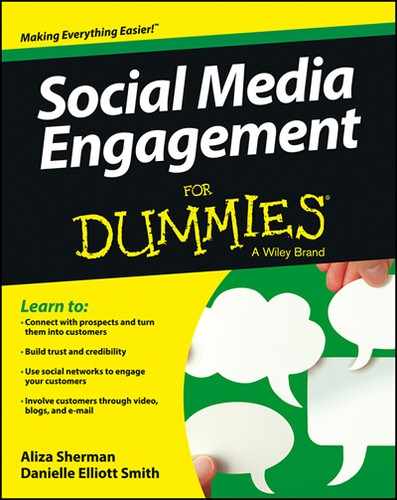Chapter 16
YouTube
In This Chapter
![]() Producing memorable, shareable content
Producing memorable, shareable content
![]() Increasing your number of subscribers
Increasing your number of subscribers
![]() Mastering the technical side of YouTube
Mastering the technical side of YouTube
![]() Building a community video experience
Building a community video experience
Online video: It isn’t simply the quickest way to learn “Gangnam Style” (to date, the most-watched YouTube video of all time, with 1.2 billion views and counting), to keep up on the latest Les Misérables Flash Mob Wedding video, or to view quirky cat videos. Video is an opportunity to connect with your audience on a personal level — to make them laugh, to teach them something new, and to engage in some very basic, but honest, show and tell. In front of the camera, it’s just you and your viewing community.
We aren’t talking about creating a one-time hit video that drives clicks; instead, we’re talking about motivating a community to keep you in their video sights permanently. Reports say that two thirds of the world’s mobile data traffic will be video by the year 2016. Will you be along for the ride?
Using Video to Build Community
In 2011, the sixth year of YouTube’s existence, 48 hours of video were uploaded every minute. By 2012, 72 hours of video made their way onto YouTube every 60 seconds. So what’s happened in these past few years? You started watching. And your friends did. You shared what you loved. The brands you trust hopped in and started to broadcast. Then you began to share their content as well. YouTube is now a community-oriented platform and social network similar to some of the others we discuss in this book.
By now, you know a community cannot exist as a one-sided conversation. If your audience shows up and you’re nowhere to be found, they leave. If they appear and your content is inconsistent or irrelevant — same result — you’re on your own.
Although some of the same community-building basics apply — establishing a presence, building trust, listening carefully, and reacting accordingly (see Part II for a refresher) — YouTube has its own unique way of doing things. That’s what we discuss in this chapter. You want a community that isn’t expecting you to produce a video that entertains them for a few seconds, but is expecting content that continues to engage them so they never miss what you have to say.
Capturing your audience’s attention
We have a friend who runs a series of successful one-day conferences for beginning bloggers. Bloggy Boot Camp is the brainchild of Tiffany Romero and Francesca Banducci. Tiffany commands the room the moment she wants her audience’s attention by saying, “If you can hear me, clap once!” She pauses to wait for the response that always follows: a clap and then silence. She repeats, “If you can hear me, clap twice!” Two claps and another round of silence follow. Tiffany is to a live audience what you want to be to your online video viewers. The beginning of your video is your “clap.” From that moment, you have their full attention. Your goal is to keep it.
YouTube works best not for that single amazing viral video, but for the channels producing an amazing viewing experience for their communities on a regular basis. You want people to watch and to continue watching. Stopping by your channel is great, but staying for the stories you tell in each of your videos is the longer-term goal.
Think of YouTube as an opportunity to show and tell in a way you can’t with any other platform. According to Nielsen Wire, more than 147 million Americans watch video on the Internet. Those are eyeballs you want. Consider these best practices to capture your YouTube audience’s attention:
![]() Create regular content. You must update your YouTube Channel regularly. It’s up to you whether you post a new video every Monday, Wednesday, and Friday, or only once a week. However, your audience must know what to expect from you, and you must stick by whatever commitment you decide to make. A YouTube Channel last updated six months ago might as well not exist.
Create regular content. You must update your YouTube Channel regularly. It’s up to you whether you post a new video every Monday, Wednesday, and Friday, or only once a week. However, your audience must know what to expect from you, and you must stick by whatever commitment you decide to make. A YouTube Channel last updated six months ago might as well not exist.
 Post or share in plain sight when you plan to update your YouTube page — either in your banner or in your channel trailer — so your audience knows what to expect from you and when.
Post or share in plain sight when you plan to update your YouTube page — either in your banner or in your channel trailer — so your audience knows what to expect from you and when.
![]() Remember that first impressions rule. The first ten seconds of your video are crucial, as well as your screenshot (the picture visible when your video isn’t playing). Compel your audience to click Play and then to stay with you. Be funny and engaging, and give your audience a feel for what to expect. The first impression is more important than how long your video is.
Remember that first impressions rule. The first ten seconds of your video are crucial, as well as your screenshot (the picture visible when your video isn’t playing). Compel your audience to click Play and then to stay with you. Be funny and engaging, and give your audience a feel for what to expect. The first impression is more important than how long your video is.
![]() Know that production value matters. If your audience cannot see you or hear you, they will click away instantly. It doesn’t matter how compelling your content may be; you must ensure a certain level of quality. Lighting, sound, the framing of your shots, a still camera, and even some editing keeps people engaged.
Know that production value matters. If your audience cannot see you or hear you, they will click away instantly. It doesn’t matter how compelling your content may be; you must ensure a certain level of quality. Lighting, sound, the framing of your shots, a still camera, and even some editing keeps people engaged.
 Use YouTube's video editing tools to edit, make minor adjustments, or add some special effects to your video. You can trim videos to a specific length, combine multiple videos, add music from a library of approved songs, or even include custom special effects (
Use YouTube's video editing tools to edit, make minor adjustments, or add some special effects to your video. You can trim videos to a specific length, combine multiple videos, add music from a library of approved songs, or even include custom special effects (www.youtube.com/editor).
![]() Use annotations. Annotations are text content that you can lay over your video, including a link to any page within YouTube and a call to action. Annotations can prompt your viewers to subscribe to your YouTube Channel, such as your video, or link to another one of your channels. Keep annotations small and unobtrusive to offer a small nudge in the right direction. Figure 16-1 shows how to encourage a Thumbs Up by using an annotation. A Thumbs Up is a simple way for a viewer to say ‘I like this video.’
Use annotations. Annotations are text content that you can lay over your video, including a link to any page within YouTube and a call to action. Annotations can prompt your viewers to subscribe to your YouTube Channel, such as your video, or link to another one of your channels. Keep annotations small and unobtrusive to offer a small nudge in the right direction. Figure 16-1 shows how to encourage a Thumbs Up by using an annotation. A Thumbs Up is a simple way for a viewer to say ‘I like this video.’
We cover annotations in more detail in “Using annotations and thumbnails,” later in this chapter.
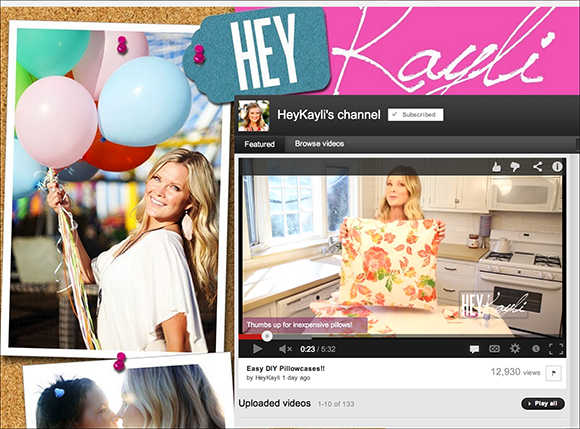
Figure 16-1: HeyKayli uses annotations throughout her videos, encouraging viewers to like the videos and subscribe.
![]() Make content meaningful. Your videos should answer a question, solve a problem, or make people laugh. You want your audience to look out for your videos and want to see more. Create content that is helpful, interesting, or intriguing in some way.
Make content meaningful. Your videos should answer a question, solve a problem, or make people laugh. You want your audience to look out for your videos and want to see more. Create content that is helpful, interesting, or intriguing in some way.
![]() Create playlists. To make it easy for your community to navigate your channel, group similar content in a YouTube video playlist. For more details, see “Creating a playlist,” later in this chapter.
Create playlists. To make it easy for your community to navigate your channel, group similar content in a YouTube video playlist. For more details, see “Creating a playlist,” later in this chapter.
![]() Buy an ad. You have several ways to buy advertising on YouTube, including Promoted Videos that show up on the right side of a similar video, and inline ads where your short video “commercial” appears before someone else’s similar video.
Buy an ad. You have several ways to buy advertising on YouTube, including Promoted Videos that show up on the right side of a similar video, and inline ads where your short video “commercial” appears before someone else’s similar video.
Optimizing your YouTube Channel
You want your audience to dig deep when it comes to spending time on your YouTube Channel. To entice them, you need to be branded, you need to be consistent, and you need to take advantage of all of the technical tools the platform puts at your disposal. You don’t need us to tell you that your main page on your YouTube Channel is one of the first impressions you make on your audience.
Here are some ways to use YouTube’s tools to optimize, or make the most of your channel and increase engagement:
![]() Brand your channel. You want people who visit your channel to know, without a doubt, they are visiting you or your business. When they click on your main page, everything they see, hear, and feel, reminds them of you, from the colors, to the verbiage to the pictures you choose to represent you.
Brand your channel. You want people who visit your channel to know, without a doubt, they are visiting you or your business. When they click on your main page, everything they see, hear, and feel, reminds them of you, from the colors, to the verbiage to the pictures you choose to represent you.
In early 2013, YouTube changed the look and feel of the main page, streamlining the change across all channels to ensure all pages would be equally visible and branded on all devices.
The new One Channel option, shown in Figure 16-2, allows you to create a branded banner across the top of the page as well as a personalized trailer to welcome people who have yet to subscribe. Use these options to sell yourself. This is more than a typical bio; this is your chance to tell people why they should watch you as well as what to expect from your videos. You also have room to include links to all of your other social media engagement platforms.
![]() Set expectations. In addition to telling your audience when you will update, tell them what to expect from your content. If you plan to do classes on selecting seasonal produce, for example, list this information in the short bio form on your YouTube trailer. The first 45 characters of your description are visible whenever a new viewer discovers your channel, even on a mobile device, so make them compelling.
Set expectations. In addition to telling your audience when you will update, tell them what to expect from your content. If you plan to do classes on selecting seasonal produce, for example, list this information in the short bio form on your YouTube trailer. The first 45 characters of your description are visible whenever a new viewer discovers your channel, even on a mobile device, so make them compelling.
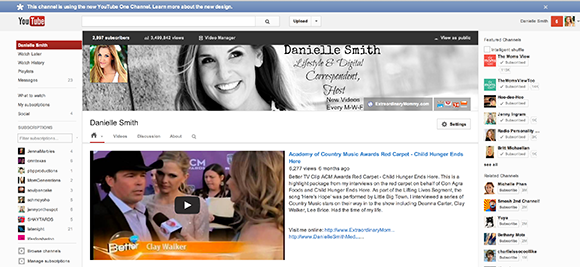
Figure 16-2: Danielle’s banner is branded, showing her name, her face, and how frequently she updates her channel.
![]() Prioritize playlists. Keeping your audience around as long as possible is a priority, so make your content as user-friendly as possible. Playlists let you group your videos together into categories such as recipes and business tips. We discuss playlists in “Creating a playlist,” later in this chapter.
Prioritize playlists. Keeping your audience around as long as possible is a priority, so make your content as user-friendly as possible. Playlists let you group your videos together into categories such as recipes and business tips. We discuss playlists in “Creating a playlist,” later in this chapter.
![]() Feature other channels. We could simply say use good karma to boost engagement, because featuring other YouTube Channels on your page lets your audience know who in the online video space is in your community, who you recommend, and who recommends you. In the new One Channel layout (see Figure 16-2), the Featured channels you select show up on the right side of your YouTube channel’s page.
Feature other channels. We could simply say use good karma to boost engagement, because featuring other YouTube Channels on your page lets your audience know who in the online video space is in your community, who you recommend, and who recommends you. In the new One Channel layout (see Figure 16-2), the Featured channels you select show up on the right side of your YouTube channel’s page.
 Anytime people subscribe to your channel, some of your featured channels are also recommended to them. The same is true in the reverse: Anyone who features you is recommending you to new subscribers.
Anytime people subscribe to your channel, some of your featured channels are also recommended to them. The same is true in the reverse: Anyone who features you is recommending you to new subscribers.
![]() Call your viewers to action. Tell your viewers what you need from them by including a call to action. This is as simple as asking your viewers to like or share your video or to subscribe to your channel by mentioning it in your video or using annotations (see “Using annotations and thumbnails,” later in this chapter). When viewers take any of these actions, these actions are broadcast to their viewers in your Channel Feed (see the next point), which is much like your Timeline format on Facebook. This, in turn, helps your audience to grow as you are then visible to a whole new set of eyeballs.
Call your viewers to action. Tell your viewers what you need from them by including a call to action. This is as simple as asking your viewers to like or share your video or to subscribe to your channel by mentioning it in your video or using annotations (see “Using annotations and thumbnails,” later in this chapter). When viewers take any of these actions, these actions are broadcast to their viewers in your Channel Feed (see the next point), which is much like your Timeline format on Facebook. This, in turn, helps your audience to grow as you are then visible to a whole new set of eyeballs.
![]() Keep an active Channel Feed. Your Channel Feed is the pulse of your activity on YouTube. When you post, comment, or like a video, or subscribe to a channel, those actions show up in your activity feed. If you’re extremely active on YouTube, consider adjusting your settings so you don’t overwhelm your subscribers.
Keep an active Channel Feed. Your Channel Feed is the pulse of your activity on YouTube. When you post, comment, or like a video, or subscribe to a channel, those actions show up in your activity feed. If you’re extremely active on YouTube, consider adjusting your settings so you don’t overwhelm your subscribers.
Creating a playlist
Playlists (see Figure 16-3) make it easier for your viewers to find the related content from you. Because videos play right after the other, your audience sees more of your videos in one sitting.
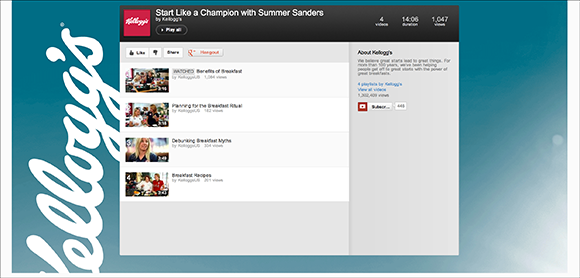
Figure 16-3: Kellogg’s YouTube page has playlists highlighting Olympic athletes.
Creating playlists also makes your content more searchable because your videos can be discovered not only individually, but also as a collection. If you create a playlist called Salad Recipes, for example, the videos are optimized in search engines not only for each specific recipe video, but also as the entire playlist.
To create a playlist to increase views and engagement, follow these steps:
1. Log in to your YouTube account.
2. Click Video Manager in the top-right corner.
All videos you have uploaded appear.
3. Click Playlists on the left side of your screen under Video Manager.
Any previous playlists you have created appear.
4. Click the New Playlist button on the right side of the screen.
5. In the Playlist Title and Description dialog box that appears, title your playlist and describe its content; then click Create Playlist.
6. In the Editing Playlist box that appears, click Add Video by URL.
A box to add the URL will appear mid-page.
7. Copy the URL of the first video you want to include in your playlist.
8. Paste the URL of the video into the Video URL box and click Add.
You’ll see a green bar that says ‘Video successfully added!’.
9. On the right side of the page, click Public and Allow Others to Embed this Playlist.
10. Click Save.
All the videos you selected are grouped in a playlist and will play automatically one right after the other when a viewer clicks on any within the grouped list.
Maximizing your subscriber base
There’s tremendous value in building your subscriber base and in increasing your community. The more subscribers you have, the more people who see each video as you post it and have the opportunity to share your video content. Sitting idly by and hoping people will stumble upon your channel is not the answer.
Fortunately, we do know a few tricks to help you increase your exposure and get more people to click Subscribe.
The three keys to building your subscriber numbers are consistency, strong content, and communication. Set a schedule and force yourself to stick to it. Your subscribers need to know what to expect from you. Posting weekly is optimal, but it’s more important that your audience have faith in your consistency. Pepsi, for example, posts two to three times a week, depending on the time of year. This consistency, combined with quality content, made Pepsi one of the biggest brand channels of 2012, according to Digiday, a media company and digital media community.
Interacting with the YouTube community
You wouldn’t be reading this book if you didn’t place high importance on engaging with your community. Mastering that interaction with your YouTube audience requires a different set of tactics and practices from the other social networking platforms we discuss in this book:
![]() When people comment on your videos, reply. The three main reasons to reciprocate are
When people comment on your videos, reply. The three main reasons to reciprocate are
• You build relationships with members of your community.
• You show you value the feedback. If someone doesn’t like your video, he’ll often let you know. Anonymous feedback is not uncommon. Consider the tougher criticism an opportunity to look for ways to improve what you do. However, do try to let excessive negativity roll off your back. You can’t take it too personally.
• The more frequently you comment, the more visible you are to your subscribers. Each time you reply to a comment, your video reappears in your subscribers’ feeds and your Channel Feed or home page.
 Consider responding to comments a few at a time so that your video reappears a few different times throughout the day on your subscribers’ main feeds. Not everyone is online at the same time, so this tactic allows a greater number of people access to your content on a regular basis.
Consider responding to comments a few at a time so that your video reappears a few different times throughout the day on your subscribers’ main feeds. Not everyone is online at the same time, so this tactic allows a greater number of people access to your content on a regular basis.
![]() Be a commenter. Don’t simply wait for people to comment on your work. Take an active role in your community. Identify those creating valuable content. March your happy self out into the wide world of YouTube and start commenting on other individuals’ and brands’ videos and clicking Like or Thumbs Up. If they are seeing your name or brand for the first time, they will hopefully be intrigued enough to visit you, watch some of your videos, and subscribe.
Be a commenter. Don’t simply wait for people to comment on your work. Take an active role in your community. Identify those creating valuable content. March your happy self out into the wide world of YouTube and start commenting on other individuals’ and brands’ videos and clicking Like or Thumbs Up. If they are seeing your name or brand for the first time, they will hopefully be intrigued enough to visit you, watch some of your videos, and subscribe.
![]() Subscribe. While you are out watching, liking, and commenting, determine which channels you would like to visit regularly and click Subscribe. Some of those channels may eventually be ones that you feature on your own channel.
Subscribe. While you are out watching, liking, and commenting, determine which channels you would like to visit regularly and click Subscribe. Some of those channels may eventually be ones that you feature on your own channel.
![]() Remove offensive comments. You have no obligation to keep offensive comments visible on your YouTube Channel. Taking the time to remove every comment that you don’t love is a waste of your time, but true spam, hatred, personal attacks, or anything else offensive can easily — and should — be taken down. As administrator of your channel, you have the tools to moderate comments.
Remove offensive comments. You have no obligation to keep offensive comments visible on your YouTube Channel. Taking the time to remove every comment that you don’t love is a waste of your time, but true spam, hatred, personal attacks, or anything else offensive can easily — and should — be taken down. As administrator of your channel, you have the tools to moderate comments.
 Don’t let spammers hijack your YouTube Channel. Allowing spam and hateful words to take up real estate can turn fans away and lead people to believe you don’t care about your channel. Block commenters who are repeatedly offensive. You can also flag for spam or simply remove their comments (see Figure 16-4).
Don’t let spammers hijack your YouTube Channel. Allowing spam and hateful words to take up real estate can turn fans away and lead people to believe you don’t care about your channel. Block commenters who are repeatedly offensive. You can also flag for spam or simply remove their comments (see Figure 16-4).
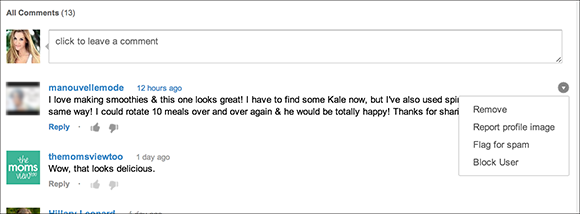
Figure 16-4: Remove anything that includes hateful or offensive language by making a choice from this drop-down menu.
Standing Out on YouTube
Millions of people produce videos every day, and thousands of those videos are good. You watch them, smile, laugh, and cry; the video ends and you move on. Certainly not every video can be a viral video and, in fact, very few are. Setting out to create a viral video is a lesson in futility.
What you want for your video is the “Watch this!” factor, even if it isn’t shared a million times. Any sharing at all is the chance to expose new people to your brand. Any one person who likes what she sees can potentially reach dozens, hundreds, or thousands of others simply because she shared your video. When this happens, you want to understand the qualities of that shared video so your next video and the one after that keeps people sharing.
Producing video content that keeps people watching
You’ve had those days when you just can’t escape that video. You know the one. The one that everyone is sharing. That popular video of the moment is on Twitter; it’s dominating your Facebook feed; it’s the topic of conversation at the work cocktail party; and even your mother calls you to tell you about it.
In October 2012, nearly 8 million people watched the live YouTube stream of Felix Baumgartner jumping from a platform nearly 128,000 feet above Earth, becoming the first person to break the sound barrier outside a vehicle. That video holds the record for the most concurrent views ever on YouTube.
As Baumgartner crushed that barrier, so did sponsor Red Bull, which was in control of the event; its logo was visible every small step of the way. To date, the Red Bull Stratos playlist, with 23 videos, has 69 million views total, with just one of the videos in that list topping 32 million (see Figure 16-5).

Figure 16-5: The Mission Accomplished video has been viewed more than 32 million times.
What made this YouTube campaign such a success? It built suspense, it was live action, and it involved branding.
Another extremely successful YouTube campaign was Old Spice’s 2010 Old Spice Guy campaign, which began with a video of actor Isaiah Mustafa wrapped in a bath towel and came fully to life as he responded by video to tweets from social media personalities across the country. The video campaign was full of humor and quickly evolved into something extraordinary, garnering more than 236 million views on YouTube and more than 80,000 Twitter followers in just two days. Old Spice had both a viral video and an astronomical increase in sales.
Mastering metadata
Suppose that your first few videos don’t go viral (and there’s a 99.9 percent chance they won’t). You need to work to bring your audience to your video and channel. Much like inviting people to your blog through search engine placement, or starting a conversation on Twitter, or posting something to Facebook, getting your video out there needs to start with you.
Because YouTube is the No. 2 search engine in the world, it makes sense to master the way people find you when they search online. This is where your title, tags, and description come in.
Your title, tags, and description, or metadata, are indexed in YouTube’s algorithm based on content. Videos are found based on promotion, ads, search, and other related videos. If you aren’t entering this information properly, you miss valuable opportunities to be found.
Title
Titles are the first things viewers see, but they aren’t only first impressions. Video titles are also key to placement within the ranks of search, so they must be good. Here are some tips for titles:
![]() Grab viewers’ attention. Make the titles compelling and clickable.
Grab viewers’ attention. Make the titles compelling and clickable.
![]() Maximize search potential. Choose keywords carefully and strategically.
Maximize search potential. Choose keywords carefully and strategically.
![]() Be honest. Don’t mislead your audience with false titles or phrases.
Be honest. Don’t mislead your audience with false titles or phrases.
![]() Put the topic first and the brand second. Begin with the subject or keywords and then include the brand or show title (see Figure 16-6).
Put the topic first and the brand second. Begin with the subject or keywords and then include the brand or show title (see Figure 16-6).
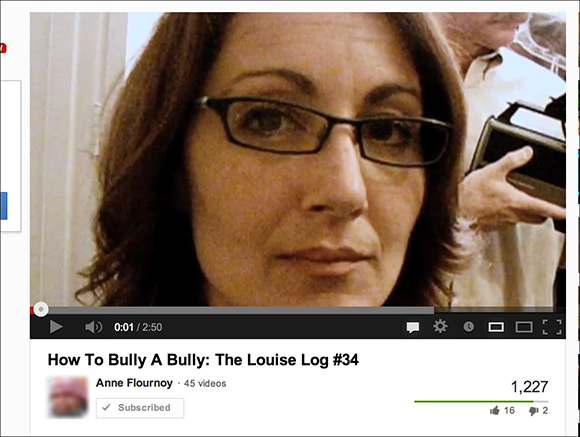
Figure 16-6: The episode (topic) title is followed by the show title.
![]() Follow up. Dig into any older videos you’ve published, and update titles for relevancy to gain additional views.
Follow up. Dig into any older videos you’ve published, and update titles for relevancy to gain additional views.
Tags
Tags help you categorize your videos, grouping your videos into the relevant topics online. Depending on how well you tag, you can determine if you’re linked to trending topics. Here are some guidelines for tagging your videos:
![]() Include a mix of broad and specific tags. Here’s an example of a broad/specific mix: Politics, Presidential Debate Denver, Mitt Romney, Barack Obama, Election 2012.
Include a mix of broad and specific tags. Here’s an example of a broad/specific mix: Politics, Presidential Debate Denver, Mitt Romney, Barack Obama, Election 2012.
![]() Add consistency. Have a standard set of tags for your channel that apply to every video you publish. For example: business advice, business tips, and social media and business.
Add consistency. Have a standard set of tags for your channel that apply to every video you publish. For example: business advice, business tips, and social media and business.
![]() Don’t go overboard. There is no must-have number of tags, but do reasonably cover all areas of your topic.
Don’t go overboard. There is no must-have number of tags, but do reasonably cover all areas of your topic.
 We’ve found that 15 tags is a good amount.
We’ve found that 15 tags is a good amount.
![]() Include the title. Make sure the title of your video is also in the tags.
Include the title. Make sure the title of your video is also in the tags.
![]() Use quotation marks. Put any phrases in quotes, such as “Mickey Mouse” and “Walt Disney World.”
Use quotation marks. Put any phrases in quotes, such as “Mickey Mouse” and “Walt Disney World.”
![]() Prioritize. List your tags based on importance, with the first ones being the most relevant.
Prioritize. List your tags based on importance, with the first ones being the most relevant.
Description
The first few sentences of your description matter most because they are the only ones fully visible when a viewer first clicks to your video. The description helps persuade a potential new viewer to watch. Here’s what you should include in your description:
![]() Keywords: Include keywords from title and tags but not your actual tags.
Keywords: Include keywords from title and tags but not your actual tags.
![]() Links: Include clickable links to other sites and social networks.
Links: Include clickable links to other sites and social networks.
![]() Time codes: If the video is long, consider including time codes, or particular moments in the video — 1:22 or 3:16 — that point to certain highlights in the video to entice people to keep watching.
Time codes: If the video is long, consider including time codes, or particular moments in the video — 1:22 or 3:16 — that point to certain highlights in the video to entice people to keep watching.
Using annotations and thumbnails
Video annotations are text and picture overlays enhancing your videos to boost your subscribers, likes, viewership, and engagement. These lines of text that appear over your actual videos are exclusive to YouTube and prompt your viewers to like or click Thumbs Up for your content, keep them watching longer, and push them to other videos on your channel.
Best uses for annotations
Some of the most effective uses of annotations include
![]() Adding a Subscribe button
Adding a Subscribe button
![]() Adding fresh content to old videos
Adding fresh content to old videos
![]() Encouraging a Thumbs Up or Like
Encouraging a Thumbs Up or Like
![]() Asking a question to engage your community
Asking a question to engage your community
![]() Linking to other videos or playlists on YouTube
Linking to other videos or playlists on YouTube
![]() Highlighting certain moments or time codes in the video
Highlighting certain moments or time codes in the video
When it comes to using annotations, use your best judgment. Don’t spam your viewers with too many, or they will feel pressured to do too much. They should be able to enjoy the experience of watching your video without feeling bombarded.
Types of annotations
As for the actual types of annotations, you have a few options:
![]() Customize your annotations based on size, shape, or color.
Customize your annotations based on size, shape, or color.
![]() Determine whether to include a link.
Determine whether to include a link.
![]() Add a speech bubble to add a little creativity to the video.
Add a speech bubble to add a little creativity to the video.
![]() Use a spotlight to highlight an area, making it clickable. The text is visible only when the viewer moves the cursor over it.
Use a spotlight to highlight an area, making it clickable. The text is visible only when the viewer moves the cursor over it.
![]() Play with the different types of annotations to determine what strategy works best for you.
Play with the different types of annotations to determine what strategy works best for you.
Best uses for thumbnails
Another important element you should never ignore is the thumbnail for your video. The thumbnail shot of your video is a teaser for what your audience can expect of your video. Ideally, you want a shot that looks good both large and small. If you or someone else is in the video, you want a thumbnail in which you or she isn’t caught with closed eyes and mouth wide open. Your thumbnail should reflect the story you’re about to tell in the video. ConAgra Foods’ Child Hunger Ends Here campaign released a video by country band Little Big Town. Viewers are instantly drawn to the video by the thumbnail of the band performing (see Figure 16-7).

Figure 16-7: A performance thumbnail draws viewers in.
Extending Your Reach with Video
Make your video work for you in more than one way. While the YouTube community is strong and spending time nurturing those relationships can be extremely important, you want the value of your video to live well beyond the walls of this platform. The more people viewing the video you create, the more your video engagement continues to grow. We’re talking about extending your power of your video to a larger audience. And while you’re out building your community in person, why not learn to do a little video on the go?
Embedding and integrating your videos
When your videos are posted to YouTube, your work isn’t done. Taking the additional time to embed those videos on other platforms can increase your reach exponentially. A good example is the Make it Count Nike video, shown embedded on Facebook in Figure 16-8. By taking the video from its home on YouTube and placing it in front of its Facebook audience, Nike started an entirely new conversation — generating hundreds of comments and thousands of likes. By embedding the video in a new location, more fans saw the video and had a chance to talk about it.
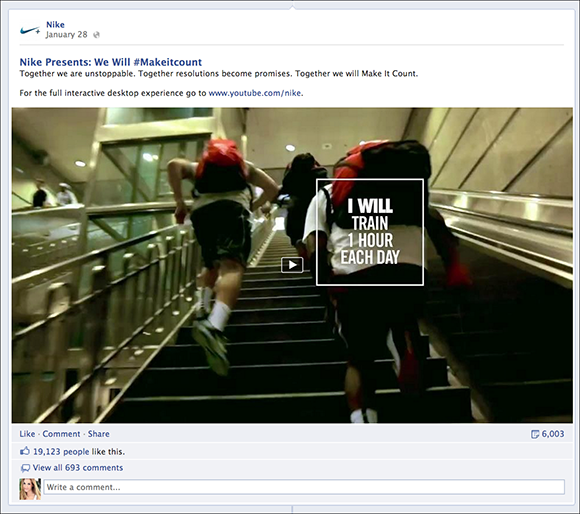
Figure 16-8: Nike’s ad campaign was liked more than 19,000 times and received nearly 700 comments on Facebook.
YouTube makes it easy for you to embed your videos on virtually any platform — you can put them on your blog or Facebook, or share them on Twitter. You can even set up a board on Pinterest specifically to showcase your YouTube videos and pin videos straight from your channel.
To embed your videos, copy the URL from a specific YouTube video and paste it onto your Facebook Fan Page, into a tweet, or onto your blog post or web page. Grab the embed code by doing the following:
1. Go to your YouTube Video.
2. Beneath the video, click the Share button.
You will see a box that says Share This Video with a URL.
3. To the right of Share This Video, click Embed.
A box with highlighted code appears.
4. Copy the HTML code into the box.
5. Paste the code into the HTML text portion of your blog post (or tweet or Facebook status).
Take the time to share your videos beyond YouTube for greater exposure so not only your current audience and community sees it, but also other people who may be seeing you for the very first time. These people are potential new subscribers and prospective customers.
Taking advantage of video responses
A creative way to join a conversation on YouTube and to increase the chance of people seeing your videos is to use the video response feature. Instead of posting a traditional comment, respond to a video with your own video. When you do this, you put yourself in front of a whole new community and gain more exposure for your video channel and your brand.
For example, say there is a hot debate about homeschooling, and you have an opinion. Plenty of videos pop up online on the topic. You want to add your voice to the conversation, so you do the following:
1. Create your video response to a hot topic.
2. Upload it to YouTube, including title, tags, and description.
3. Find a video you would like to respond to with that video response.
4. Click the Comment box as though you are going to type a comment.
5. Below the Comment box, click Create a Video Response.
All the videos you have ever created will appear within a box that says, ‘Select the video you want to respond with’.
6. Choose the video you want to use and then click Use the Selected Video.
You may occasionally see an approval notice that tells you your video will be posted after it has been approved by the Channel owner of the original video that inspired your response. Other YouTube users approve video responses automatically.
Uploading video on the go
Maybe you want to take this whole YouTube business slowly or you’re not quite certain you want to invest in a brand new digital video camera. The good news is that you probably have a suitable video camera on your mobile phone! Chances are it’s all you need to get started. Both the iPhone and Android phones make it a snap to go from point, shoot, record, upload to publish in a matter of minutes. So, you can’t use the lack-of-camera excuse to hold you back from leveraging video to engage online.
On both platforms, you can follow the sharing options after you record a video. Both iPhone and Android will allow you to enter a title, tags, and a description; opt to make the video public or private; and publish directly to YouTube.
At this time, both Windows and BlackBerry phones do not have a way to automatically upload to YouTube.
Analyzing your impact
YouTube makes it easy for you to monitor your influence online. Stats in the back end of your YouTube Channel track everything from overall performance to how many actual views your videos have received to how many minutes people spent watching your videos over the course of a month.
You can break down your analytics to the top ten most watched videos and find out at what point people stop watching certain videos — important information to know. You can also learn where your audience is in the world, if they came to you from another YouTube video or from an external site, and if they are male or female. You can even see what percentage of your audience is watching from a computer versus a mobile device. See Figure 16-9 for an example of YouTube statistics.
Paying attention to each of these statistics and adjusting accordingly can help you reach more subscribers and keep them around longer — and we all know that’s the goal.
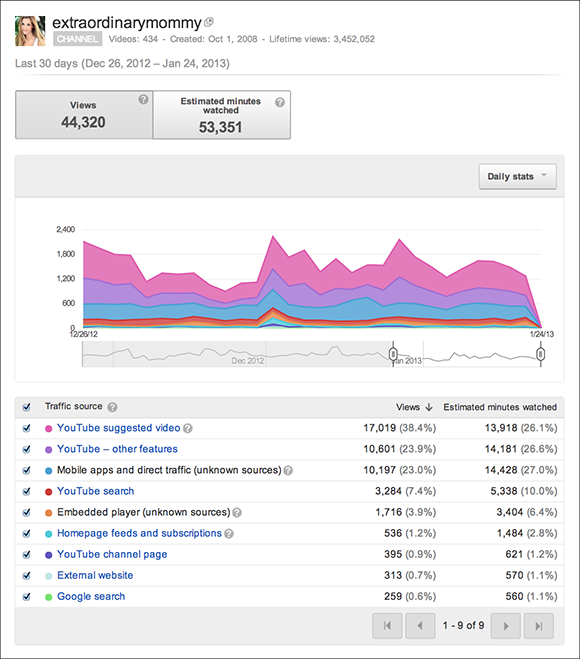
Figure 16-9: Danielle can see what percentage of her traffic is coming from within YouTube, from Google, and from elsewhere.
